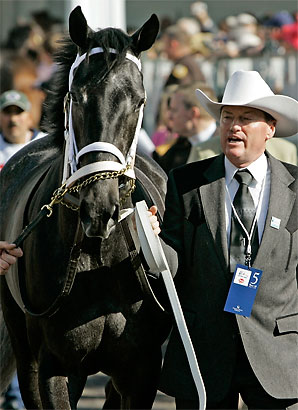Our mania for speed played a role in Eight Belles' death
More and more, sport -- especially in the United States -- is reduced to speed and power. Always, of course, the very nature of sport, its elemental base, has been: who's the fastest, or who's the strongest? But guile and gumption used to play a larger part in our games.
No one knows what killed the filly Eight Belles after the Kentucky Derby last Saturday. She looked just fine to the very moment she keeled over. It was like those sad little two-sentence notices you read in the newspaper every once in a while (and then forget) ... about some apparently healthy high school or college athlete who just suddenly, mysteriously collapses and dies at practice.
The difference with Eight Belles, though, is that she did it in the glare of her sport's largest audience. Had she died after the fifth race one Thursday afternoon at Suffolk Downs, no one would have paid much attention. But, of course, horse racing has been cursed that, all too often, the everyday tragedy has struck at its premier events. It is sufficient only to cite two names: Ruffian. Barbaro.
So the search is on for immediate villains. Was it the hard dirt track? Did her trainer use gross misjudgment in pitting a brave girl against 19 boys? PETA -- People for the Ethical Treatment of Animals -- wants to suspend the jockey, presumably for not being clairvoyant about his horse's collapse.
But the fact is, we probably will never really know. Thoroughbreds are just such incredibly fragile creatures, half-ton beasts, born with a burning desire to run, doing so on candlestick legs. There is an old Bedouin legend that best describes how wispy they really are:
"And God took a handful of southerly wind, blew his breath over it and created the horse."
But our mania for speed has made these great, delicate beasts all the more brittle. All 20 horses in the Derby were descended from one great sire -- the magnificent gray Native Dancer, who lived but a half-century ago. Add to this proliferate in-breeding the fact that drugs are allowed today in the United States that are banned most elsewhere, so that horses who have no business racing do, and then they go to stud and pass on their weaknesses. Speed, speed. European horses run more tactical races. We just go flat out.
Sterling Moss, an old star of another race sport, Formula One, once explained it best this way: "You see, we have an entirely different concept of speed in Europe. It's relative. You arrive at a 60-miles-per-hour corner, for example, and try going around it at 61. Then you'll know what speed is."
Maybe the closest thing in sport to a thoroughbred's legs is a baseball pitcher's arm. The scouts yearn only for the arms that can throw the hardest, and kid pitchers break down all the time. Young female athletes, thrown into the fray, are suffering a plague of ACL injuries. Likewise, tennis players of both sexes are walking wounded on the hard courts they pound on, their arms torn by the torque of hitting so hard with synthetic rackets. Football ball-carriers, who routinely weigh more than what linemen used to, run faster than ever. Too many of their bodies give out too, too soon. Speed. Power. Faster. Stronger.
Eight Belles was a horse. But also, really: she was one of us.





